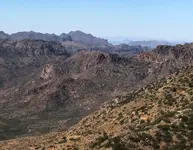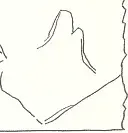Jim
I looked at the map Joe posted , but didn't make the " click " to me . There are many reasons I'm not interested in that area . One of these reasons is how the area in Joe's map don't fits with the route and clues that gave Waltz to Julia , Holmes and others . Another reason is how the horse head clue which is close to the LDM , is in another place . Even the Kochera/Haywood map is for another region .
John Reed said how when he and his father uncovered again the LDM in 1888 , they saw in the shaft bottom some drift tools and other minning stuff . This description fits with what Apache did when covered the shaft in 1882 . When Waltz came to the shaft after 1882 , he realized the shaft/incline was covered , and continued to work the " placer " which was a short distance below the shaft . When Waltz decided to cover the mine , this mine was not the shaft but the placer which became a little hole/tunnel in the ground .
Read what Apache Jack said about the shaft and the placer ( blue colour ) :
" ... the Apaches decided to hide their mine in 1882. They decided that the only way to protect their secret was to conceal it in such a manner that only the Apaches would ever be able to find it. Apache Jack was a boy of twelve when the tribe set about concealing the entrance. He reported many years later, when he was an old man, that in true Indian fashion, a band of thirty squaws and two youths labored for one full moon, throwing ore and
hastily abandoned tools back into the shaft. They then covered everything with stout logs, which were in turn covered with the natural caliche cement that hardens into rock. Over all, they placed another covering of dirt and surface stones to match the surrounding area. Finally, rocks were shifted around to disguise everything...>
Apache Jack further said that the Apache left a marker. In a steep-climbing arroyo high upon a mountainside where no white prospector would normally think of looking for gold, was
a bright yellow ribbon of it in a narrow vein of rose quartz. It lay under towering cliffs, which overhung the whole arroyo, within plain sight of nearby Weaver’s Needle, and thinking no white man would ever venture there, the Apaches did not conceal this place. Below was the secret marker, an eight-foot high boulder hoisted upon the skyline of a ridge which, because it formed an abrupt bend in the north-south trending Needle Canyon, formed also for a few hundreds yards the only south slope. This boulder had been chiseled to look like a rampant horse’s head with mouth open, one ear laid back and with the other ear standing straight up. However, it was only so recognized against the sky when viewed from down canyon a short ways to the north. "
Text from
Dutchman's Lost Mine
Also , a LDM clue says about a tunnel and above on the mountainside a shaft/incline , both rich in gold ore .









 ? The fact that the Wilderness prohibits grazing and we have a virtual "bloom" of tangled brush in the cannons and the ridge line, to me, is instructive. To me, that speaks to soil type and naturally occurring vegetation. Is the spot right to support the occurrence of heavy vegetation in protected areas? Yeap; I think it is. Nothing more than that. But it does seem to rule out other areas where such is not the case. To each his own.......nothing wrong with that. Your guess is as good as mine. Just giving you some of my thoughts to ponder.
? The fact that the Wilderness prohibits grazing and we have a virtual "bloom" of tangled brush in the cannons and the ridge line, to me, is instructive. To me, that speaks to soil type and naturally occurring vegetation. Is the spot right to support the occurrence of heavy vegetation in protected areas? Yeap; I think it is. Nothing more than that. But it does seem to rule out other areas where such is not the case. To each his own.......nothing wrong with that. Your guess is as good as mine. Just giving you some of my thoughts to ponder. 